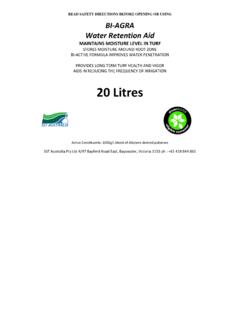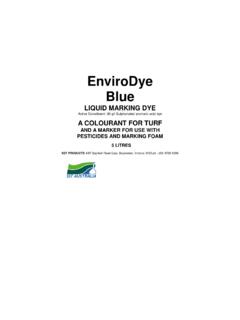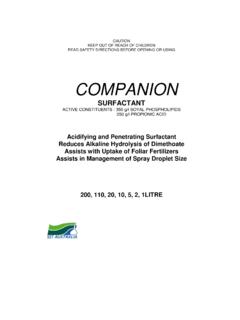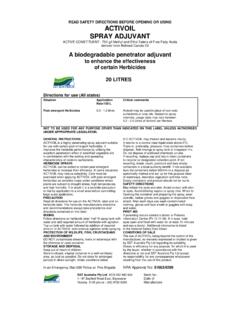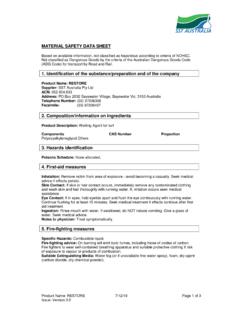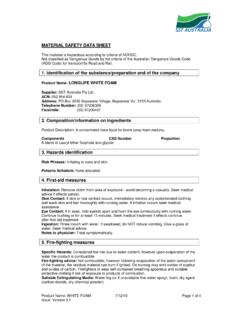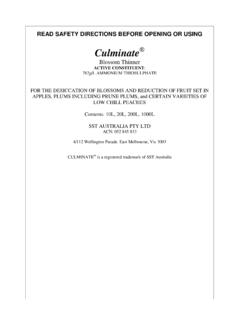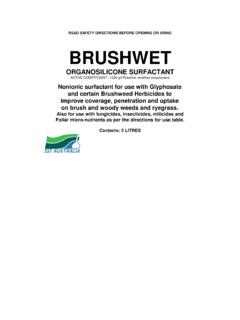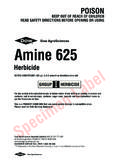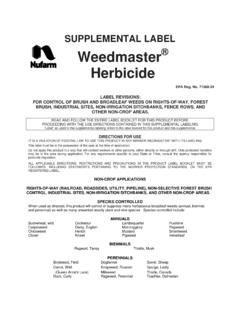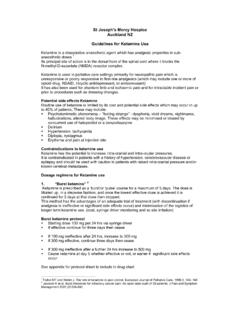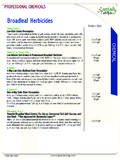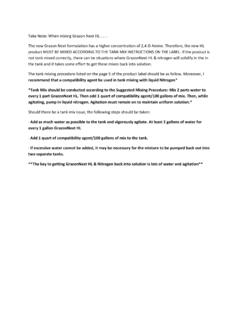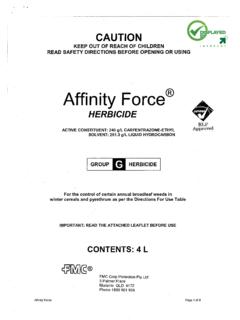Transcription of kleenupGran label 2011 FINAL - SST Australia
1 POISON S6 NOT TO BE TAKEN KEEP OUT OF REACH OF CHILDREN READ SAFETY DIRECTIONS BEFORE OPENING OR USING KLEENUP GRANULAR ACTIVE CONSTITUENTS: 80g/Kg AVAILABLE CHLORINE 380g/Kg SODIUM CARBONATE 125g/Kg SODIUM HYDROXIDE 125g/Kg SODIUM METASILICATE PENTAHYDRATE A MULTIPURPOSE DECONTAMINANT FOR PESTICIDE SPRAYING EQUIPMENT DECONTAMINATES MOST PESTICIDES RESIDUES INCLUDING SULFONYLUREA AND PHENOXY HERBICIDES EXTENDED SHELF LIFE CONTAINS BLUE TRACER DYE CONTENTS 10 Kg HAZARD CLASSES , , , , , , , ECOTOXIC, TOXIC HSR002591 SAFETY WARNING: Harmful. May be harmful if swallowed, inhaled or absorbed through the skin. Severe eye irritant. Corrosive to eyes and skin. ENVIRONMENTAL WARNING: Aquatic, soil and vertebrate ecotoxicant. Avoid contaminating waterways.
2 DIRECTIONS FOR USE: CHEMICAL TYPE SITUATION USE RATE DECONTAMINATION TIME Sulfonylurea Herbicides including: Chlorsulfuron, Metsulfuron, Triasulfuron, Sulfometuron, Halosulfuron, Bensulfuron, Iodosulfuron, Sulfosulfuron, Rimsulfuron, Thifensulfuron, Mesosulfuron Trifloxysulfuron Spray tanks, hoses, lines and all associated spray equipment 150 - 250 grams per 100L Let the unit stand for 15 to 30 minutes. Note! Use lower rate if Kleenup Granular is less than 12 months from manufacture date. Use higher rate if Kleenup Granular is 12 24 months from manufacture date. Nozzles and screens/filters 25 grams / 10L 30 Minutes Phenoxy Herbicides including: 2,4-D Amine, 2,4-D Ester, Picloram, Triclopyr, Dicamba, MCPA, Flumetsulam Spray tanks, hoses, lines and all associated spray equipment 500 grams per 100L Let the unit stand for 4 6 hours or preferably overnight.
3 Nozzles and screens/filters 50 grams / 10L 30 Minutes Non-Persistent Chemicals Most other pesticides except where directed not to use chlorine containing products. Spray tanks, hoses, lines and all associated spray equipment 100 grams / 100L Not required Nozzles and screens/filters 10 grams / 10L 30 Minutes NOT TO BE USED FOR ANY PURPOSE, OR IN ANY MANNER, CONTRARY TO THIS label UNLESS AUTHORISED UNDER APPROPRIATE LEGISLATION. GENERAL CLEANOUT PROCEDURE 1. Clean spray equipment immediately after spraying is completed. 2. Hose down the outside of the unit, otherwise herbicide adhering to the outside could contaminate the unit again after it has been cleaned. 3. Drain the tank, then flush tank, boom and hoses with clean water for a minimum of 10 minutes. 4. Half fill the tank with clean water and begin agitation. 5. Remove filter basket in top of tank.
4 6. Slowly add required amount of KLEENUP GRANULAR. 7. Replace filter basket in top of tank and fill with water. 8. Agitate and circulate solution through all lines and run sprayer to fill the boom. 9. Agitate vigorously for 15 minutes and recirculate. 10. Use the hand lance or return hose to clean the top of the tank and around the filter basket. Care should be taken to wash out any indentations or ledges in the tank where herbicide could be deposited. 11. Adopt DECONTAMINATION TIME if directed above. 12. Open spray booms and spray out. 13. Fill with clean water, recirculate, and flush through thoroughly. 14. For Sulfonylurea and Phenoxy herbicides it is a sensible precaution to repeat steps 4 12 before clean water flush. WHEN SPRAYER IS TO BE REUSED IMMEDIATELY 15. Half fill the tank with water. 16. Add 10ml/100L of a defoaming agent such as FOAMEX.
5 17. Fill the remainder of the tank with water. 18. Agitate for 5 minutes and recirculate before spraying out. 19. Rinse and flush with clean water. Process is complete when blue tracer dye is no longer seen in wash water. Note! This procedure is important to ensure that there is no chlorine residue in excess foam not removed from tank while switching between sprays that could decontaminate following treatment. NOZZLES AND SCREENS/FILTERS Remove and clean separately. Immerse in solution of KLEENUP GRANULAR and allow to stand for 30 minutes. Remove any residue with a wire brush. Rinse in clean water before re-connection to boom. STAIN AND SCALE REMOVAL FROM SPRAY EQUIPMENT Add 40 grams Kleenup Granular per 10 Litres of water. Mix in a bucket and scrub stained areas with stiff brush. Wear rubber gloves. Rinse in clean water before re-connection to boom.
6 GENERAL INSTRUCTIONS KLEENUP GRANULAR is a cost effective, proprietary pesticide decontaminant containing a mixture of Available Chlorine, Caustic Soda, Sodium Metasilicate Pentahydrate and a highly effective wetting agent which is designed to cleanout and decontaminate virtually all pesticide residues from spraying equipment. KLEENUP GRANULAR is more concentrated and has an extended shelf life compared to other liquid decontaminants. Treatment with KLEENUP GRANULAR should be carried out when changing between pesticide types and for end of season cleanup. HANDLING PRECAUTION This product will generate heat and become unstable if it comes into contact with small amounts of moisture. To avoid hazardous situations handle this product carefully as follows: 1. Replace lid firmly on product immediately after required quantity is taken. 2.
7 Maximum agitation must be running prior to addition of product to spray tank. 3. Spray tank must be at least half full of water before addition of product to tank. 4. Filter basket should be removed before addition through top port of tank. 5. Required quantity of product should be measured out using a dry measuring vessel. STORAGE AND DISPOSAL WHEN STORING: Always store in closed, original container in a cool, well ventilated area out of direct sunlight. Triple, or preferably pressure rinse containers before disposal, adding rinsing to wash tub. Do not dispose of undiluted chemicals on site. If recycling, replace lid and return clean containers to recycler or designated collection point. If not recycling, break, crush or puncture and bury empty containers in a local authority landfill. If no landfill is available, bury the containers below 500mm in a disposal pit specifically marked and set up for this purpose clear of waterways, desirable vegetation and tree roots.
8 Empty containers should not be burnt. SAFETY DIRECTIONS CORROSIVE. Product is poisonous if swallowed. The product is alkaline. Attacks skin and eyes. May produce severe burns. Will irritate the throat. Do not inhale vapour. Ensure adequate ventilation when using. Avoid contact with skin, eyes and clothing. When preparing and using solution wear elbow length neoprene gloves, face shield or goggles. Do not mix with hot water. Do not mix with other chemicals. Do not mix with different types of chlorinating chemicals. Mix with water only. If product or solution is on skin, immediately wash area with soap and water. In case of spillage, flush with large quantities of water. Wash hands after use. After each day s use wash gloves, face shield or goggles and contaminated clothing. FIRST AID If poisoning occurs, contact a doctor or Poisons information Centre on 13 11 26 or for New Zealand call National Poisons Centre 0800 POISON (0800 764 766).
9 If swallowed DO NOT induce vomiting. Give a glass of water. If skin contact occurs, remove contaminated clothing and wash skin thoroughly. If in eyes, hold eyes open, flood with water for at least 15 minutes and see a doctor. Additional information is contained in the Material Safety Data Sheet which is available from the reseller at point of purchase or visit for alternate contact details in NZ. CONDITIONS OF SALE The use of Kleenup Granular being beyond the control of the manufacturer, no warranty expressed or implied is given by SST Australia Pty Ltd regarding its suitability, fitness or efficiency for any purpose for which it is used by the buyer, whether in accordance with the directions or not and SST Australia Pty Ltd accepts with no responsibility for any consequences whatsoever resulting from the use of this product.
10 In an Emergency PH NUMBER IN NZ IS Batch No.: SST Australia PTY LTD ACN 052 845 833 Dial 000 NATIONAL POISONS CENTRE Date of 4 / 97 Bayfield Road East, Bayswater, VIC, 3153 Police or Fire Brigade 0800 POISON (0800 764 766) Manufacture Telephone : (03) 9720 6306 NZ + 61 418 844 861 24Hr number +61 418 844 861 UN 1759 CORROSIVE SOLID ( CONTAINS DISODIUM TRIOXOSILICATE), (CONTAINS SODIUM HYDROXIDE) Hazchem 2X. Packaging Group III. Class 8
